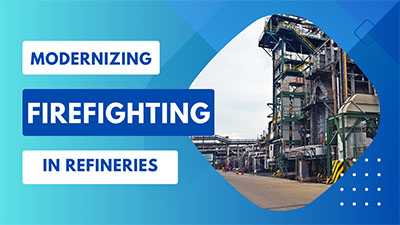Modernizing Refineries: Fire Suppression and Environmental Compliance
In an era of increasing environmental consciousness, petrochemical refineries across the globe are upgrading their processes and production units to meet new environmental standards. As the demand for cleaner and greener energy rises, the need for refinery modernization becomes more pressing.
However, this trend towards sustainable practices brings challenges for fire personnel who protect these aging facilities. Many refineries were constructed before 1950, and their ageing infrastructure, coupled with the potential issues arising from mineral buildup in the water supply system, poses significant obstacles for fire suppression efforts.
This article explores refinery modernization and its impact on fire suppression. We will also discuss what you can do to begin addressing some of these challenges at your refinery.
The Global Trend Towards Refinery Modernization
Petrochemical refineries play a vital role in processing crude oil into various products and are known for their significant environmental impact. To address concerns about air and water pollution, greenhouse gas emissions, and energy efficiency, governments and regulatory bodies worldwide are implementing stricter environmental standards for the industry. Refineries must invest in upgrading their processes and adopting cleaner technologies to ensure compliance and reduce their ecological footprint.
This global trend towards refinery modernization has gained momentum over the past decade. Now, refineries are focusing on improving energy efficiency, reducing emissions, and integrating renewable energy sources into their operations. As a result, older facilities are being retrofitted or replaced with more efficient and eco-friendly units.
Challenges for Fire Fighters
The aging infrastructure of many petrochemical refineries creates significant challenges for fire fighters tasked with safeguarding these facilities. Outdated infrastructure is more susceptible to corrosion, leaks, and equipment failures, increasing the risk of fire incidents. Additionally, the fire protection systems, including piping networks, may not be designed to handle the demands of modern fire suppression techniques.
One potential issue firefighters may face is the presence of tuberculation in the water supply system. Tuberculation refers to the accumulation of mineral deposits, mainly iron oxide, within the piping network. Over time, tuberculation reduces the pipe diameter, restricts water flow, and affects pressure capabilities. These factors can complicate fire suppression efforts, impeding the ability to deliver an adequate water supply to extinguish fires effectively.
Addressing the Challenges
To overcome the challenges associated with aging infrastructure and tuberculation, refineries, their internal fire or safety personnel, and local fire departments should collaborate to implement solutions that ensure the safety of personnel and protect critical assets. Here are four strategies that are being implemented around the globe:
-
Infrastructure Upgrades: Refineries are investing in infrastructure upgrades, including replacing aging pipes, tanks, and storage facilities. Modern materials and corrosion-resistant alloys are now utilized to enhance the longevity and integrity of the infrastructure, reducing the risk of leaks and failures.
-
Fire Suppression System Improvements: Fire departments and refinery safety personnel are working together to upgrade fire suppression systems. This includes replacing outdated equipment with state-of-the-art technologies, such as high-capacity pumps, advanced sprinkler systems, automated fire detection and control systems, modern firefighting monitors, durable intake and discharge valves, and more. These improvements increase the reliability and effectiveness of fire suppression efforts.
-
Water Supply Optimization: Refineries are conducting regular inspections and maintenance of their water supply systems to address issues related to tuberculation. They are employing specialized cleaning techniques and implementing corrosion control measures to restore pipe functionality, improve water flow, and improve pressure capabilities.
-
Training and Preparedness: Fire departments are updating their training programs to ensure personnel are well-equipped to handle emergencies in modernized refineries. Specialized training in new technologies, equipment, and safety protocols is crucial for effective incident response. Conducting joint drills and simulations can also improve preparedness.
Conclusion
The global trend towards refinery modernization, driven by stricter environmental standards, is reshaping the petrochemical industry. While these advancements are essential for reducing environmental impact and embracing sustainable practices, they can also aid fire suppression efforts and provide a natural opportunity to upgrade outdated systems.
By effectively modernizing both processes and fire protection measures, petrochemical refineries can ensure the safety of personnel, protect critical assets, and meet the demands of a greener and more sustainable future.
